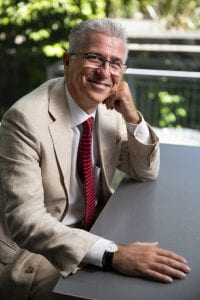 My technical background is in aerospace structures and mechanisms, and my activities span from academic research & teaching to consultancy for industry, covering both theoretical work and experimental activity. In addition, the natural progression of my career has increased my management responsibilities, giving me the opportunity to lead multidisciplinary research groups, developing strategies to ensure sustainable growth and supervising their implementation, managing the appropriate resources.
My technical background is in aerospace structures and mechanisms, and my activities span from academic research & teaching to consultancy for industry, covering both theoretical work and experimental activity. In addition, the natural progression of my career has increased my management responsibilities, giving me the opportunity to lead multidisciplinary research groups, developing strategies to ensure sustainable growth and supervising their implementation, managing the appropriate resources.
I graduated with a first class honours degree in Aerospace Engineering and my career started as a stress analyst at Alenia Spazio (Turin I) working at the Columbus module of the International Space Station. I then worked at ESA-ESTEC (Noodrwijk NL) on various payloads for the Space Shuttle programme, and in 1995 moved to the University of Southampton where I obtained a PhD and later a Lectureship in Aerospace Structural Dynamics. I progressed though my academic career and I was awarded a personal Chair in Aerospace Structures becoming the head of the Astronautics Research Group.
In 2013 I moved to the Surrey Space Centre, to take up the Royal Academy of Engineering Research Chair in Space Engineering co-sponsored by Surrey Satellite Technology, and later became director of the Centre, ultimately responsible for the activities of its research groups (approximately 90 individuals, including academics, research/support staff and postgraduate researchers). The centre worked on a range of topics from space missions design and delivery, to hardware development (from concept design & analysis, to manufacturing assembly and testing) to downstream applications, including our educational & knowledge transfer activities. I have also been active on the teaching front, delivering modules on space engineering at UG and PG level, on Continuing Professional Education courses for Industry and as Director of the Masters course in Space Engineering.
Some of the results of my academic research work have found applications in various industrial hardware developments, from satellites subsystems to whole satellite analysis and testing related activities, contributing to European Space Agency guidelines. In parallel with my academic work I have carried out consultancy work on various aspects of spacecraft structures for most of the key players in the UK space industry, SSTL, Astrium (now Airbus defence and Space), MSSL, SSBV, SULA Systems, Lockheed Martin, ABSL, JCR Systems, SIL.
Besides my academic and consultancy work, I also lead the development and execution, of space missions to demonstrate technologies ranging from space debris removal (e.g. the RemoveDebris mission) to in orbit demonstration of hardware developed by UK companies (e.g. AlSat-1N) supporting knowledge transfer towards developing countries.
In 2019, I moved to NZ to lead the Auckland Space Institute, with the mandate to establish research and educational activities to support the development of the local space sector.
Research interests
My research activity has been sponsored by various institutions (European Space Agency, Innovate UK, EPSRC, Royal Academy of Engineering, Nuffield Foundation, UK Space Agency and others) and various companies operating in the space sector, such as SSTL and Astrium (now Airbus defence and Space).
Some of the topics covered in this research are: active and passive control of microvibrations on board satellites, mechanical design of electronic equipment for aerospace applications, multifunctional spacecraft structures; deployable structures; spacecraft stable structures, vibration testing & isolation, virtual shaker testing, actuators design, and model correlation & validation. Some of the work has directly contributed to ESA flagship missions like BepiColombo, and successful commercial satellites like the SSTL DMC3 constellation.
My academic work is described in over 240 publications, and has been presented at the major conferences, including invited and plenary key note talks.
Besides my personal academic research, I have led the development and execution of experimental space missions. Two representative examples are:
The Alsat 1N mission, to demonstration in orbit of hardware developed by UK companies, whilst simultaneously acting as a vehicle for a Knowledge Transfer programmes to support the development of the space sector in Algeria.
The RemoveDebris mission, launched the 2nd of April 2018 to demonstrate technologies for space debris removal, that has attracted significant media attention from major international news outlets: CNN, BBC, The Times, The Guardian, Wall Street Journal, etc. ).
More info: https://unidirectory.auckland.ac.nz/profile/guglielmo-aglietti
Email: g.aglietti@auckland.ac.nz
For info on open funded PhD projects supervised by Prof Aglietti, please see our Opportunities page